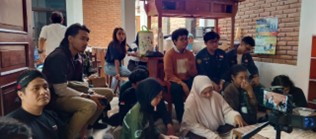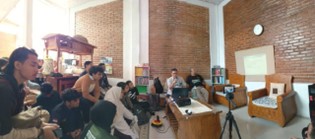
Yogya (22/6), the Master’s and Doctoral Study Program in Environmental Science, Gadjah Mada University Postgraduate School, conducted an Ecoliteracy School, which was the second part of the continuation of the activities carried out on June 15th 2024 which discussed waste management patterns. On this occasion, the ecoliteracy school again inspired students to actively discuss the management of aquatic ecosystems, especially regarding river and water management with theme “Rivers and Water: Characteristics, Management, Problems and Impacts, Condition of Our Water and Rivers” presenting guest speaker Ir. Agus Prasetya, M.Eng.Sc., Ph.D. from the UGM Faculty of Engineering with scientific fields in chemical engineering and technical wastewater treatment processes.
Taking place at Mr. Taufik Hidayat’s house, Bromonilan Village RT 5 RW 3 Purwomartani, Kalasan, Sleman, DI Yogyakarta, this activity was attended by students from the Gadjah Mada University Postgraduate School, especially students from the Master’s and Doctoral Study Program in Environmental Science. There are many government regulations and laws that regulate environmental management related to the preservation of aquatic ecosystems, however it will be a crucial matter to always discuss in line with the development of companies or initiators and the increasing number of residents who have an influence on aquatic ecosystems.
In his presentation, Agus Prasetya, Ph.D. explained that problems in river management are related to environmental components, namely abiotic, biotic and cultural. Abiotic problems in river management include rubbish pollution, waste and degradation. The biotic problem in river management is biodiversity. In the cultural or community component, river management problems are related to the quantity of water, whether it is too much (floods), too little (drought), and too dirty (floods, the quality below the quality standards). Examples of river management problems in the field are shown by the phenomenon of flooding in the Wulan River, Demak in 2024 and the phenomenon of rivers becoming dumping grounds for rubbish and waste, with the worst being in the Citarum River (1 day 1 ton of rubbish). So, it is hoped that organic waste will not be removed from the house.
Remembering that “Nature is the best designer”, river management should pay attention to the natural shape of the river itself. Searching for information and/or past data accommodates this, namely through ancient maps, past photos, past books and papers, as well as old people.
Students discussed with each other by asking questions and their views regarding the process of managing river and water ecosystems. The discussions were on phenomena regarding waters that are currently occurring, such as the phenomenon of increasing eutrophication and the presence of water hyacinth, the condition of the Pabelan River which is currently used to control lava, rivers in Kalimantan as a possible transportation route so that erosion does not reach the water body, and discussions regarding concentrated water affected by mining waste. All of this requires public awareness to be able to maximize the use of environmental resources while maintaining the preservation of aquatic ecosystems.
Tags: ecoliteracy, aquatic ecosystems, SDG, SDG 4: quality of education, SDG 6: clean water consumption and sanitation, SDG 14: protecting marine ecosystems
Author: Siti Muyasaroh


